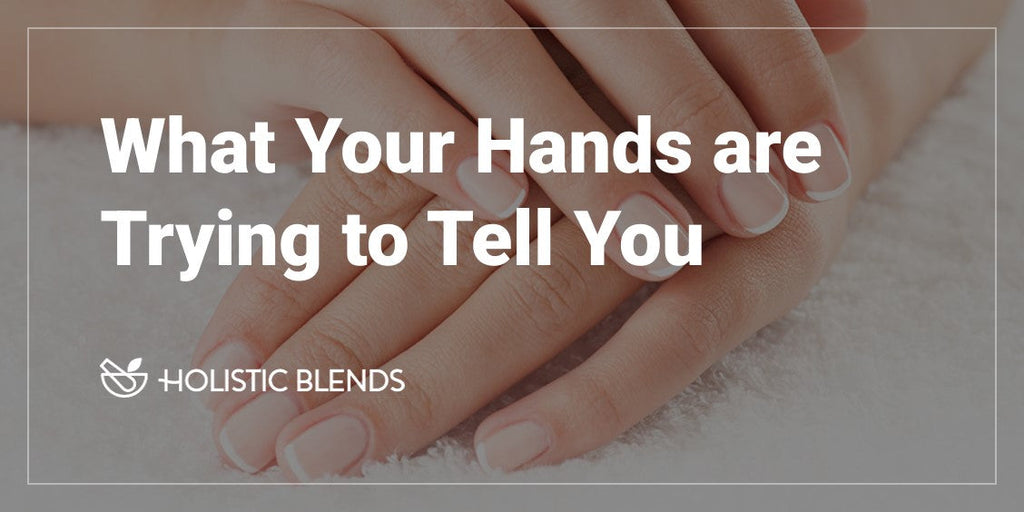If you’ve been a reader of mine for a while, you may recall that I’ve written several times about subtle signs that your body gives you when things aren’t quite right.
Take for instance your “products of excrement.” You can learn a whole lot from looking in the toilet bowl at your urine or feces before you flush.
The tongue is another example.
A healthy tongue should be very light red to pinkish and free of cracks, ridges and white coating. Any deviations from the norm can suggest a variety of issues.
Well, there’s another part of your anatomy that may be quietly trying to tell you something about your health and it’s important that you pay attention.
Your hands!
Here are some common health clues that you can see in your hands and how you can help address the potential issues:
Your nails
A healthy nail should be smooth and have a slight pinkish tint.
Pale nails suggest iron-deficiency anemia. When your body is low in iron, which is crucial for red blood cell production, your nails can lose their healthy pink tone. The paleness is the result of reduced hemoglobin in the red blood cells, which are responsible for transporting oxygen throughout your body.
Yellow nails can be the result of many things, from nail polish staining to lung issues, diabetes and fungal infections.
Bluish nails are indicative of low oxygen and suggest a lung or heart issue.
White spots on the nails are a sign of zinc deficiency.
Aside from color, there are other nail signs that your body may give you:
The nail plate separating from the nail bed and/or brittle nails that break easily are commonly caused by hypothyroidism (low functioning thyroid).
And while vertical ridges on the nail surface are frequently associated with aging (due to slower cell turnover), they can also be an indication of nutrient deficiencies, especially iron, zinc, and vitamins A, C and D.
How you can help
With nutrients
First and foremost, if you suspect a serious issue, such as a lung or heart problem, see your doctor.
In addition to that, as you can see, issues with your nails many times are tied to lacking various nutrients…so, my friend, that means it’s a good idea to take a look at your diet.
If your four food groups consist of pizza, pasta, burgers and fries, and Taco Bell, it’s time to change that. It’s crucial to incorporate nutritious real foods into your diet—fresh fruits and vegetables, meats, poultry, fish, eggs, full-fat dairy, nuts and seeds and healthy fats like real butter and olive oil.
Now, you don’t have to do a complete 180 all at once! Even taking baby steps in the right direction and gradually changing your diet will help.
And if you want to make sure all your nutrient bases are covered, nothing beats our very own Super Core multi-vitamin and mineral formula!
Super Core contains health-supporting doses of essential vitamins and minerals, plus an impressive array of disease-fighting natural anti-inflammatories and antioxidants too!
Support your thyroid
As I mentioned above, hypothyroidism is a common culprit behind nail issues.
But the good news is that recent research has supported the fact that the herb ashwagandha can help improve thyroid function!
Although these studies are current, the fact is, ashwagandha has been used for thousands of years in Ayurvedic medicine to help support the body’s proper endocrine functions and promote mental clarity and alertness.
You can put the power of ashwagandha to work for you with our very own newly reformulated Ashwa Blend Gummies!
Now let’s turn our attention to… The skin on your hands
Some of the most common issues with the skin on your hands include:
Dry skin
Dry skin on the hands is a common complaint, especially during the colder months or with frequent handwashing.
But dry hands can also be the result of eczema--a skin condition characterized by itchy, red, and cracked skin. Eczema is considered an autoimmune condition, meaning your immune system is hypersensitive and overactive, and is attacking your healthy skin cells.
Although eczema can affect skin anywhere on your body, your hands are a common target.
In addition, hypothyroidism can play a part here too and lead to severe dryness and cracking of your skin. Thyroid hormones play a crucial role in maintaining healthy skin (and really your health from head to toe). So, when your thyroid gland is underactive, it can lead to dry, rough skin that is more prone to cracking.
Warts
Warts commonly appear on the back of the hands and are typically associated with HPV (human papilloma virus) infection.
While HPV is contagious and there is no cure for the virus, most people will naturally fight off the virus from their body within 2-3 years of getting it. However, it can come back in the form of warts!
How you can help
Vitamin D has been shown to help tame the overzealous inflammatory reactions typically seen with autoimmune diseases like eczema. Unfortunately, vitamin D is also a widespread deficiency due to our fears of skin cancer, avoiding sun exposure and use of sunscreens.
To help ensure your body has health-supporting levels of vitamin D, check out our Optimum DK Formula with Fruite-X B! Each dose provides 5,000 IUs of vitamin D3, plus vitamins K1 and K2 and the mineral boron.
And here too, if you suspect your thyroid may be sluggish, in addition to getting tested by your doctor, Ashwa Blend Gummies can help.
To naturally clear warts, below are two things you can try:
1. Apple Cider Vinegar (ACV)
Soak a cotton ball in apple cider vinegar, apply it to the wart, wrap it with a band-aid or gauze and leave it on overnight. Continue this process each night until the wart is gone.
2. Hydrogen peroxide
Soak a cotton swab in a full-strength solution of 35% food-grade hydrogen peroxide, then rub it onto the wart carefully. Make sure you don’t touch any healthy, normal skin with the peroxide, as this may sting. Repeat 3 to 5 times per day for a week or two or until the wart is gone.
Note: Be sure to keep hydrogen peroxide away from children and pets.
Take a good look at YOUR hands and see what they may be trying to tell you!
To your health,
Sherry Brescia











